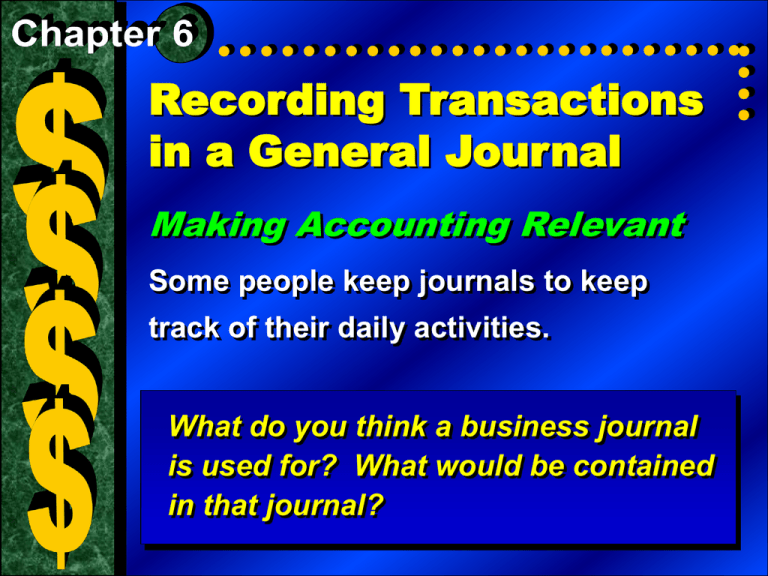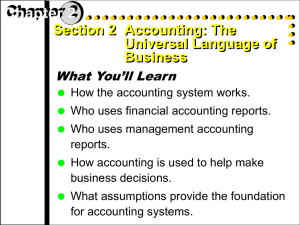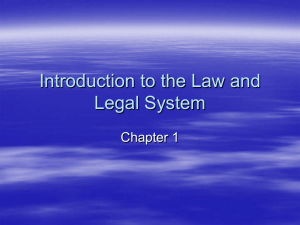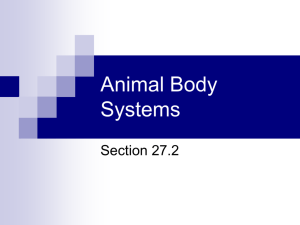Chapter 6 Section 1 The Accounting Cycle (con't.)
advertisement

Recording Transactions in a General Journal Making Accounting Relevant Some people keep journals to keep track of their daily activities. What do you think a business journal is used for? What would be contained in that journal? Section 1 The Accounting Cycle What You’ll Learn The first three steps in the accounting cycle. Why is it necessary to journalize transactions. The different kinds of source documents used in a business. The difference between a calendar year and a fiscal year. Section 1 The Accounting Cycle (con’t.) Why It’s Important In the real world, businesses follow a similar accounting cycle, record transactions in a general journal, and operate within a predefined accounting period. Key Terms accounting cycle source document invoice receipt memorandum check stub journal journalizing calendar year fiscal year Section 1 The Accounting Cycle (con’t.) The Steps of the Accounting Cycle Section 1 The Accounting Cycle (con’t.) The First Step in the Accounting Cycle: Collecting and Verifying Source Documents The accounting cycle starts by collecting and verifying the accuracy of source documents. Source document is a paper prepared as evidence of that transaction. Section 1 The Accounting Cycle (con’t.) The First Step in the Accounting Cycle: Collecting and Verifying Source Documents (con’t.) Invoice: Lists specific information about a business transaction involving the buying or selling of an item. The invoice contains the date of the transaction, along with the quantity, description, and cost of each item. Section 1 The Accounting Cycle (con’t.) The First Step in the Accounting Cycle: Collecting and Verifying Source Documents (con’t.) Receipt: A record of cash received by a business. It indicates the date the payment was received, the name of the person or business from whom the payment was received, and the amount of the payment. Section 1 The Accounting Cycle (con’t.) The First Step in the Accounting Cycle: Collecting and Verifying Source Documents (con’t.) Memorandum: A brief written message that describes a transaction that takes place within a business. Often used if no other source document exists for the business transaction. Section 1 The Accounting Cycle (con’t.) The First Step in the Accounting Cycle: Collecting and Verifying Source Documents (con’t.) Check Stub: The check stub lists the same information that appears on a check: the date written, the person or business to whom the check was written, and the amount of the check. The check stub also shows the balance in the checking account before and after each check is written. Section 1 The Accounting Cycle (con’t.) The Second Step in the Accounting Cycle: Analyzing Business Transactions Analyzing information on the source documents to determine the debit and credit parts of each transaction. Section 1 The Accounting Cycle (con’t.) The Third Step in the Accounting Cycle: Recording Business Transactions in a Journal Record the debit and credit parts of each business transaction in a journal. A journal is a record of all of the transactions of a business. The process of recording business transactions in a journal is called journalizing. Section 1 The Accounting Cycle (con’t.) The Accounting Period accounting records are summarized for a certain period of time, called an accounting period most businesses use a year as their accounting period begins on January 1 and ends on December 31 calendar year fiscal year is an accounting period of twelve months Section 1 The Accounting Cycle (con’t.) Check Your Understanding Businesses separate their accounting records into accounting periods. Why is this procedure important for keeping meaningful accounting records?






